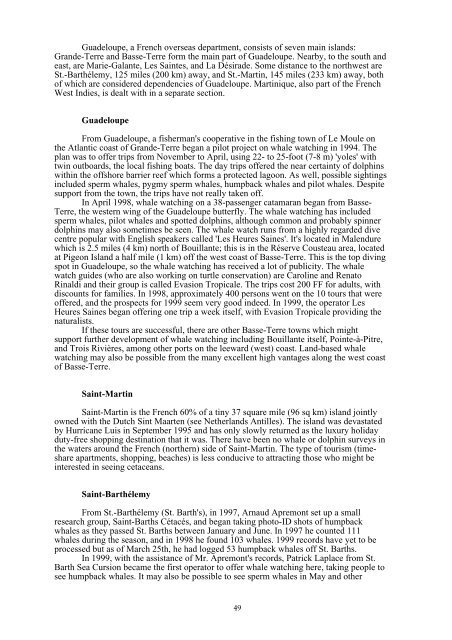The Potential of Whale Watching in the Caribbean: 1999+
The Potential of Whale Watching in the Caribbean: 1999+
The Potential of Whale Watching in the Caribbean: 1999+
You also want an ePaper? Increase the reach of your titles
YUMPU automatically turns print PDFs into web optimized ePapers that Google loves.
Guadeloupe, a French overseas department, consists <strong>of</strong> seven ma<strong>in</strong> islands:<br />
Grande-Terre and Basse-Terre form <strong>the</strong> ma<strong>in</strong> part <strong>of</strong> Guadeloupe. Nearby, to <strong>the</strong> south and<br />
east, are Marie-Galante, Les Sa<strong>in</strong>tes, and La Désirade. Some distance to <strong>the</strong> northwest are<br />
St.-Barthélemy, 125 miles (200 km) away, and St.-Mart<strong>in</strong>, 145 miles (233 km) away, both<br />
<strong>of</strong> which are considered dependencies <strong>of</strong> Guadeloupe. Mart<strong>in</strong>ique, also part <strong>of</strong> <strong>the</strong> French<br />
West Indies, is dealt with <strong>in</strong> a separate section.<br />
Guadeloupe<br />
From Guadeloupe, a fisherman's cooperative <strong>in</strong> <strong>the</strong> fish<strong>in</strong>g town <strong>of</strong> Le Moule on<br />
<strong>the</strong> Atlantic coast <strong>of</strong> Grande-Terre began a pilot project on whale watch<strong>in</strong>g <strong>in</strong> 1994. <strong>The</strong><br />
plan was to <strong>of</strong>fer trips from November to April, us<strong>in</strong>g 22- to 25-foot (7-8 m) 'yoles' with<br />
tw<strong>in</strong> outboards, <strong>the</strong> local fish<strong>in</strong>g boats. <strong>The</strong> day trips <strong>of</strong>fered <strong>the</strong> near certa<strong>in</strong>ty <strong>of</strong> dolph<strong>in</strong>s<br />
with<strong>in</strong> <strong>the</strong> <strong>of</strong>fshore barrier reef which forms a protected lagoon. As well, possible sight<strong>in</strong>gs<br />
<strong>in</strong>cluded sperm whales, pygmy sperm whales, humpback whales and pilot whales. Despite<br />
support from <strong>the</strong> town, <strong>the</strong> trips have not really taken <strong>of</strong>f.<br />
In April 1998, whale watch<strong>in</strong>g on a 38-passenger catamaran began from Basse-<br />
Terre, <strong>the</strong> western w<strong>in</strong>g <strong>of</strong> <strong>the</strong> Guadeloupe butterfly. <strong>The</strong> whale watch<strong>in</strong>g has <strong>in</strong>cluded<br />
sperm whales, pilot whales and spotted dolph<strong>in</strong>s, although common and probably sp<strong>in</strong>ner<br />
dolph<strong>in</strong>s may also sometimes be seen. <strong>The</strong> whale watch runs from a highly regarded dive<br />
centre popular with English speakers called 'Les Heures Sa<strong>in</strong>es'. It's located <strong>in</strong> Malendure<br />
which is 2.5 miles (4 km) north <strong>of</strong> Bouillante; this is <strong>in</strong> <strong>the</strong> Réserve Cousteau area, located<br />
at Pigeon Island a half mile (1 km) <strong>of</strong>f <strong>the</strong> west coast <strong>of</strong> Basse-Terre. This is <strong>the</strong> top div<strong>in</strong>g<br />
spot <strong>in</strong> Guadeloupe, so <strong>the</strong> whale watch<strong>in</strong>g has received a lot <strong>of</strong> publicity. <strong>The</strong> whale<br />
watch guides (who are also work<strong>in</strong>g on turtle conservation) are Carol<strong>in</strong>e and Renato<br />
R<strong>in</strong>aldi and <strong>the</strong>ir group is called Evasion Tropicale. <strong>The</strong> trips cost 200 FF for adults, with<br />
discounts for families. In 1998, approximately 400 persons went on <strong>the</strong> 10 tours that were<br />
<strong>of</strong>fered, and <strong>the</strong> prospects for 1999 seem very good <strong>in</strong>deed. In 1999, <strong>the</strong> operator Les<br />
Heures Sa<strong>in</strong>es began <strong>of</strong>fer<strong>in</strong>g one trip a week itself, with Evasion Tropicale provid<strong>in</strong>g <strong>the</strong><br />
naturalists.<br />
If <strong>the</strong>se tours are successful, <strong>the</strong>re are o<strong>the</strong>r Basse-Terre towns which might<br />
support fur<strong>the</strong>r development <strong>of</strong> whale watch<strong>in</strong>g <strong>in</strong>clud<strong>in</strong>g Bouillante itself, Po<strong>in</strong>te-à-Pitre,<br />
and Trois Rivières, among o<strong>the</strong>r ports on <strong>the</strong> leeward (west) coast. Land-based whale<br />
watch<strong>in</strong>g may also be possible from <strong>the</strong> many excellent high vantages along <strong>the</strong> west coast<br />
<strong>of</strong> Basse-Terre.<br />
Sa<strong>in</strong>t-Mart<strong>in</strong><br />
Sa<strong>in</strong>t-Mart<strong>in</strong> is <strong>the</strong> French 60% <strong>of</strong> a t<strong>in</strong>y 37 square mile (96 sq km) island jo<strong>in</strong>tly<br />
owned with <strong>the</strong> Dutch S<strong>in</strong>t Maarten (see Ne<strong>the</strong>rlands Antilles). <strong>The</strong> island was devastated<br />
by Hurricane Luis <strong>in</strong> September 1995 and has only slowly returned as <strong>the</strong> luxury holiday<br />
duty-free shopp<strong>in</strong>g dest<strong>in</strong>ation that it was. <strong>The</strong>re have been no whale or dolph<strong>in</strong> surveys <strong>in</strong><br />
<strong>the</strong> waters around <strong>the</strong> French (nor<strong>the</strong>rn) side <strong>of</strong> Sa<strong>in</strong>t-Mart<strong>in</strong>. <strong>The</strong> type <strong>of</strong> tourism (timeshare<br />
apartments, shopp<strong>in</strong>g, beaches) is less conducive to attract<strong>in</strong>g those who might be<br />
<strong>in</strong>terested <strong>in</strong> see<strong>in</strong>g cetaceans.<br />
Sa<strong>in</strong>t-Barthélemy<br />
From St.-Barthélemy (St. Barth's), <strong>in</strong> 1997, Arnaud Apremont set up a small<br />
research group, Sa<strong>in</strong>t-Barths Cétacés, and began tak<strong>in</strong>g photo-ID shots <strong>of</strong> humpback<br />
whales as <strong>the</strong>y passed St. Barths between January and June. In 1997 he counted 111<br />
whales dur<strong>in</strong>g <strong>the</strong> season, and <strong>in</strong> 1998 he found 103 whales. 1999 records have yet to be<br />
processed but as <strong>of</strong> March 25th, he had logged 53 humpback whales <strong>of</strong>f St. Barths.<br />
In 1999, with <strong>the</strong> assistance <strong>of</strong> Mr. Apremont's records, Patrick Laplace from St.<br />
Barth Sea Cursion became <strong>the</strong> first operator to <strong>of</strong>fer whale watch<strong>in</strong>g here, tak<strong>in</strong>g people to<br />
see humpback whales. It may also be possible to see sperm whales <strong>in</strong> May and o<strong>the</strong>r<br />
49
















